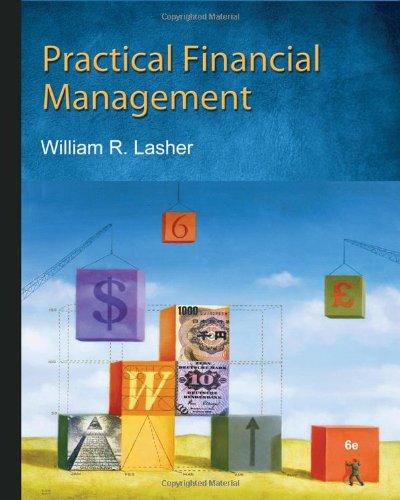

This is my homework for Advanced Corporate Finance course. There are total five questions. I hope to get the answer within one day.
f E Maw-gr; ~ - / Last Name , First Name Advanced Corporate Finance HW 2 Please show your work and explain your answers. Write legibly in the space provided. QUESTION 1: You and your business partner just inherited a rental property that has the same rental income due each year, on the rst day of the year, for the next fty years, with the first payment to you due immediately. Rather than split the annual income of $200, your business partner offers you the following choices. Which one should you choose? Please explain. You should use a 10% discount rate assumption in your calculations, and assume that both of you will survive for the entire 50year period. (4 points) A. He offers to pay you $1,150 today so that he can receive the entire rental stream going forward B. He offers to take the rst 15 payments (with you receiving that last 35 payments) C. He offers to take the rst 10 payments, and the last 10 payments (with you receiving the rest of the payments) D. He offers to pay you $600 today, and $1,500 at the end of 10 years so that he can receive the entire rental stream E. He offers to pay you seven payments of $350 spaced 3 years apart, with the rst payment to be made immediately, so that he can receive the entire rental stream QUESTION 2'. A local coffee shop is evaluating whether it should add donuts to its menu. To produce the donuts, the shop has to invest in a new donut machine. The shop projects that the new machine will last for only 3 years, and generate revenues of $20,000 in year one, $12,000 in year two and $10,000 in year three. The company will incur costs of goods sold of 70% of sales, and will need to cover operating expenses (not including depreciation) of $500 per year, regardless of sales volume. The donut machine, which will require an immediate capital expenditure of $3,000, will be fully depreciated in equal amounts over the 3year life. The coffee shop faces a tax rate of 40%. Assuming a cost of capital of 15%, and assuming no change in net working capital associated with investing in the new donut machine, what is the Net Present Value of this opportunity? (5 points) QUESTION 3: If you could invest in only one of the following investment opportunities, which would you choose? Please explain. The discount rate for each project is 8%. Project A requires an immediate initial investment of $700 and pays $450 at the end of 1 year, and $400 at the end of 2 years. Project B requires an immediate initial investment of $400 and pays $425 at the end of 1 year, and $75 at the end of 2 years. Project C requires an immediate initial investment of $600 and pays $75 at the end of 1 year, and $675 at the end of 2 years. (3 points) A. Project A B. Project B C. Project C QUESTION 4: Active Co. is a consolidator in its industry, and has purchased several of its competitors. As of December 31, 2008, Active Co. is cmrently considering a purchase of Easy Picking Inc. The following nanciai statement information is available for Easy Picking Inc. for the scal year ending on December 31, 2008. (5 points) Income Statement Revenue $30,000 COGS $ 15,000 Gross Prot $15,000 SG&A $5,000 Depreciation $3 ,000 '\\\\ EBIT $7,000 1 Taxes@40% $2,800 EBIAT $4,200 The working capital as of December 31, 2008 is $3,000. Sales are expected to grow at 3% per year. In the past, Active Co. has been able to reduce COGS through volume purchase discounts, and that COGS after December 31, 2008, will only be 40% of sales. Depreciation and the tax rate are projected to remain the same, while SG&A and Working Capital will remain the same percentage of sales as in 2008. The business will require capital expenditures of $1,500 per year. Active Co. uses a discount rate of 15%. Assume that all cash ows occur at the end of the year. After 2009, Active Co. assumes FCF will grow at 3% per year in perpetuity. What is the maximum price that Active should be willing to pay for Easy Picking? QUESTION 5: You recently inherited a valuable stamp collection from a distant relative, currently valued at $75,000. You have absolutely no interest in stamp collecting, and since it has no sentimental value, you decide that your goal should be to maximize the value of the inheritance. Stamp experts have examined the collection, and based on current market conditions, they have told you that the value of the collection will increase according to the schedule provided below. Assuming that you could earn a 12% rate of return on a comparable investment, and that there is no ination and there are no storage costs, when should you sell the stamp collection? (3 points) Expected increase in value Year 1 13% Year 2 9% Year 3 15% Year 4 11% A New B. At the end of Year 1 C. At the end of Year 2 D At the end of Year 3 E At the end of Year 4













